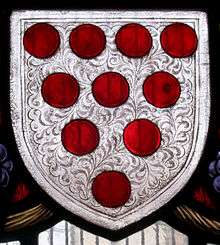Diapering

Diaper is any of a wide range of decorative patterns used in a variety of works of art, such as stained glass, heraldic shields, architecture, and silverwork. Its chief use is in the enlivening of plain surfaces.
Etymology
For the etymology see "diaper," meaning children's nappy. Oxford dictionary gives us the Greek dia for "cross" as in "diamond" or "diagonal," and aspros, Greek for "white". A white diamond or white cloth is used on the diagonal, hence the diagonal lattice or reticulation in patterning.
In art
In architecture and other decorative arts, diaper is applied as a decorative treatment of a surface with a repeat pattern of squares (chequers), rectangles, or lozenges. Diaper was particularly used in mediaeval stained glass to increase the vividness of a coloured pane, for example the field in a shield of arms.[1] A stone wall may be decorated with such a pattern sculpted in relief; in brickwork the effect may be achieved by using bricks of different colours, or by allowing certain bricks to protrude from the wall's surface to create a regular diamond-shaped pattern. In English flushwork limestone and dark knapped flint are used. Windows may be set in a diamond-shaped lattice.[2]
Heraldry

In heraldry, diapering is a technique in which those who emblazon, draw, paint, or otherwise depict achievements of arms decorate large areas of flat colour by drawing crosshatches or arabesques. There is no standard, and each artist is allowed individual idiosyncrasies.
Excluded from blazon
With very rare exceptions, diapering is not a part of the blazon, but is mere decoration, or ornamental accessory. Thus a shield with diapering is considered the same as a shield of the same design but without diapering. For this reason diapering must not be so obtrusive or so heavily drawn that it could be mistaken for a substantive charge or for a variation of the field. This is especially the case with diaper of simple cross-hatching which might be mistaken for a field of lozengy.
Exceptions
There are at least three Scots coats whose blazon includes diaper:
- Fulton of Lochliboside, Az. diapered or semy of fleurs de lys of the last, on a fess arg. two boar's heads erased of the field (Public Register vol 1, p 551, 1789);
- Fulton of Park of Inchinnan, a difference of the above, Az. diapered or semy of fleurs de lys of the last, on a fess arg. a boar's head erased of the field (Public Register vol 1. pp 550–1:
- Royal Burgh of Cullen, a 20th-century armorial: Per fess sable and argent, in chief on a sedilla or cushioned gules diapered or the Blessed Virgin enthroned proper habited gules mantled azure crowned or and holding in her dexter hand a sceptre surmounted of a fleur de lis or and in her sinister arm the Holy Child enhaloed also proper in base a talbot passant of the first (Public Register, vol 41, p 37, 1956)
Examples
| Wikimedia Commons has media related to Diapering in heraldry. |
 Diaper on the Heraldic shield of William de Valence, 1st Earl of Pembroke (d.1296) from his tomb in Westminster Abbey. Champlevé enamel
Diaper on the Heraldic shield of William de Valence, 1st Earl of Pembroke (d.1296) from his tomb in Westminster Abbey. Champlevé enamel.jpg) Diaper work at Crewe Hall
Diaper work at Crewe Hall
References
- ↑ Boutell, Charles, Heraldry Historical & Popular, London 1863, p.36
- ↑ Vadnal, Jane. "Glossary of Medieval Art and Architecture: Diaper". University of Pittsburgh. Retrieved April 11, 2010.
- ↑ Debrett's Peerage 1968, p.849, Duke of Northumberland arms, 1st & 4th grand quarters
- ↑ Norwich Guildhall